|
 Amanita muscaria Amanita muscaria
SynonymsAgaricus muscarius
BiostatusPresent in region - Exotic
Images (click to enlarge)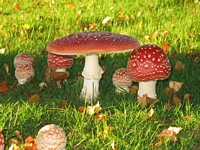
Owner: B. Dee | 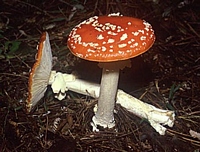
Caption: Amanita muscaria
Owner: Kaimai Bush | 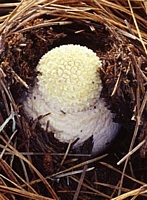
Caption: Amanita muscaria
Owner: Kaimai Bush | 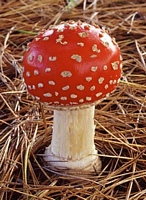
Caption: Amanita muscaria
Owner: Kaimai Bush | 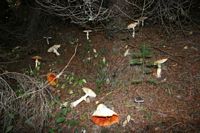
Owner: Herb. PDD | 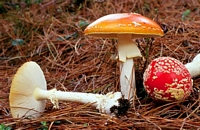
Caption: Pureora Foray, 1998
Owner: Peter Buchanan | 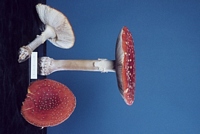
Owner: Herb. PDD | 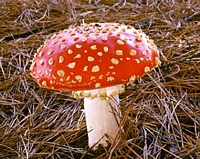
Caption: Amanita muscaria
Owner: Kaimai Bush | 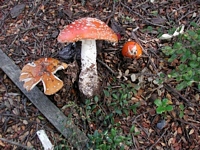
Caption: fruitbody with Nothofagus
Owner: J.A. Cooper | 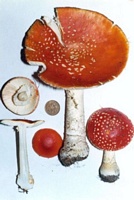
Owner: J.A. Cooper |  | 
Owner: I. Dickie | |
Article: Ridley, G.S. (1991). The New Zealand species of Amanita (Fungi: Agaricales). Australian Systematic Botany 4(2): 325-354.
Description: Basidiocarps medium to large, solitary to gregarious. Pileus to 130 mm, convex to plano- convex, then plano-depressed, margin sulcate (c. 0.07 R), entire, disc scarlet, paling to orange at the margin, then developing a metallic bronze appearance, viscid when young or wet, drying with age, volva remnants forming squarish to pointed, white warts on disc, becoming narrow, flocculent patches towards margin, often arranged concentrically. Lamellae crowded, free, 6- 10 mm wide, white; lamellulae subtruncate. Stipe to 170 mm high, 20-23 mm diameter, hollow, from bulbous base, 32-33 mm diameter, surface above annulus floccose to pulverulent, striate, white, below annulus sparsely floccose, white to sordid white, basal bulb crowned with concentric bands or squarish warts. Annulus membranous, pendulous then adhering to stipe, white to primrose. Context of pileus white, with orange to pale luteous directly under the pileipellis, stipe white.
Spore print white. Basidiospores (20/2), 9-10.5 x 7-5-8 µm, Qm 1. 38, Q 1. 12-1.40, subglobose to broadly ellipsoid, hyaline, inamyloid. Basidia 50-63. 5 x 10-13 µm, 4-spored, not clamped. Lamella margin cells indistinct. Pileipellis composed of c. 460 µm wide, gelatinised suprapellis, and dense, non-gelatinised subpellis. Volva remnants from pileus composed of globose, elliptic or clavate, hyaline cells, to 40 x 20 µm, with abundant hyphae to 8 µm wide; tending to vertically arranged on the disc, less so towards the pileus edge.
Article: Horak, E. (1971). A contribution towards the revision of the Agaricales (Fungi) from New Zealand. New Zealand Journal of Botany 9(3): 403-462 (http://www.rsnz.org/publish/abstracts.php).
Notes: This conspicuous species occurs in New Zealand under various exotic trees where
it forms mycorrhizas, and there is no question that this agaric is an introduced
species. However, like Stevenson (25), we found many fruiting bodies of this
species in native bush with Nothofagus and Leptospermum. It would be interesting
to know if this introduced mycorrhizal fungus can change its host and form
partnerships with these two indigenous genera which normally form ectotrophic
mycorrhizas with numerous indigenous Agaricales. The wide host range of A.
muscaria sugests that this possibility is not unlikely.
Article: Stevenson, G. (1962). The Agaricales of New Zealand: II. Kew Bulletin 16(1): 65–74.
Description: This species often reaches large size in New Zealand, up to 25 cm. diam.
and 30 cm. tall. Spores are 8-10 x 11-12um which agrees with the dimen-
sions given by Bresadola and is a little larger than 9.5-10.5 x 7-8 which is
given by Lange (1935). Colour and other features agree exactly with those
of European specimens.
Notes: It is very abundant throughout the north island of New Zealand and the
northern part of the south island where it is associated with the commonly
planted exotic tree, Pinus radiata. However, although P. radiata plantations
are numerous further south, A. muscaria is not found with them, its place
apparently being taken by Boletus luteus. Besides being associated with Pinus
this species has been collected also under Betula, under Spanish Chestnut,
in a shrub garden and also once (Stevenson at Lake Rotoiti, Nelson) in
Cyathodes scrub near Nothofagus; all these occurrences were far distant from
any pine trees.
Article: Gadgil, P.D. (in association with Dick, M.A.; Hood, I.A.; Pennycook, S.R.) (2005). Fungi on trees and shrubs in New Zealand. Fungi of New Zealand. Ngā Harore o Aotearoa 4: xi + 437 p. Hong Kong: Fungal Diversity Press.
Description: Type: Mycorrhizal Fungi; Description: Basidiomata pileate. Pileus scarlet, paling to orange at the margin, up to 130 mm in diameter, sprinkled with remnants of the volva forming white warty patches which are often arranged concentrically, convex at first, becoming almost plane later, viscid when young, dry later; flesh firm, white. Gills crowded, free, white. Stipe tapering slightly towards the pileus from a bulbous base, white and striate above a membranaceous white to yellowish annulus, white to dirty white below, hollow, up to 170 mm long. Basidiospores subglobose to broadly ellipsoid, 0-septate, 9–11 × 7–8 μm, hyaline, non-amyloid; spore print white.
Distribution: Distribution: Northland, Auckland, Coromandel, Waikato, Bay of Plenty, Taranaki, Taupo, Wanganui, Wellington, Gisborne, Hawkes Bay, Wairarapa, Nelson, Fiordland, Marlborough, North Canterbury, Mid Canterbury, Dunedin, Southland, Chatham Islands.; 1st Record: Birch (1937).
|